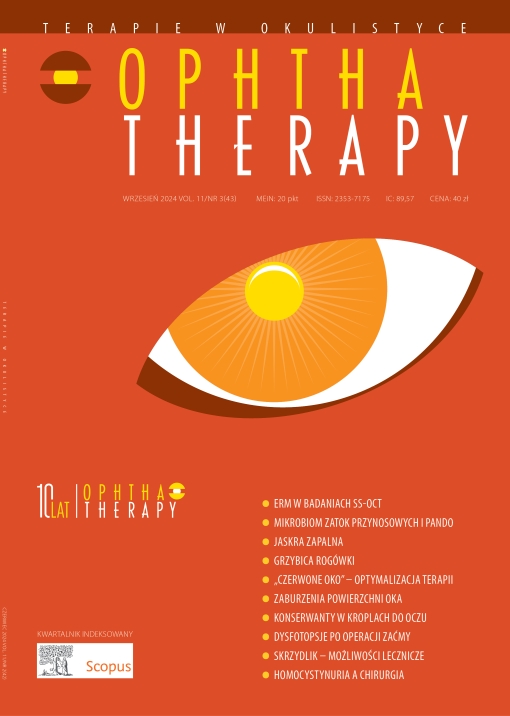Monofocal plus lens – a perfect solution for (nearly) every patient? Surgeons’ own experience with RayOne EMV Artykuł oryginalny
##plugins.themes.bootstrap3.article.main##
Abstrakt
Objective: This article aims to briefly characterise the most popular IOLs on the market and focus on Rayner EMV: monofocal plus lens being a very good compromise between a good deal of spectacle independence, its price and coexisting ocular conditions allowing for its implantation. Setting the postoperative refraction at minimonovision as was done in this study allows for even greater depth of field and thus minimalizes the need for glasses when performing most everyday activities.
Methods: To summarise the IOLs characteristics a literature search was conducted. In the second part of the article surgeons’ own experience is shown together with postoperative results and patients’ satisfaction survey.
Results: Uncorrected binocular visual acuity was very high: 74% of patients reached 6/6 on Snellen chart or better, and for 96% of patients mean UCVA both eyes was 6/6.5 or better. Mean binocular UCVA both eyes was 6/5.5. Near visual acuity score: 43% of patients did not require spectacle correction for near reading and 91% of patients were able to read line D-0,75 or more on Snellen reading chart. Halo or glare effect were noted in 5 cases but only in two of them resulted in lower score in patients’ satisfaction questionnaire (to 64 and 79% of maximum score). In three remaining cases patients gave 95% of maximum score and stated that even though they noted halo and / or glare it did not comprise their visual quality. In patients’ satisfaction questionnaire score given by drivers was 90%; non-drivers were even more satisfied and gave 92% of maximum score – it shows very high percentage of satisfied patients in both groups.
Conclusion: Rayner EMV IOL is an affordable and valuable option for patients who would like to increase their spectacle independence postoperatively and should be considered along with premium multifocal IOLs. Reducing spectacle dependence with the pseudophakic mini-monovision technique could improve the functionality, independence and quality of life for many patients.
Pobrania
##plugins.themes.bootstrap3.article.details##
Copyright: © Medical Education sp. z o.o. License allowing third parties to copy and redistribute the material in any medium or format and to remix, transform, and build upon the material, provided the original work is properly cited and states its license.
Address reprint requests to: Medical Education, Marcin Kuźma (marcin.kuzma@mededu.pl)
Bibliografia
2. Kanclerz P, Toto F, Grzybowski A et al. Extended Depth-of-Field Intraocular Lenses: An Update. Asia Pac J Ophthalmol (Phila). 2020; 9(3): 194-202.
3. de Vries NE, Webers CA, Touwslager WR et al. Dissatisfaction after implantation of multifocal intraocular lenses. J Cataract Refract Surg. 2011; 37(5): 859-65.
4. Vega F, Alba-Bueno F, Millán MS et al. Halo and Through-Focus Performance of Four Diffractive Multifocal Intraocular Lenses. Invest Ophthalmol Vis Sci. 2015; 56(6): 3967-75.
5. Mendicute J, Kapp A, Lévy P et al. Evaluation of visual outcomes and patient satisfaction after implantation of a diffractive trifocal intraocular lens. J Cataract Refract Surg. 2016; 42(2): 203-10.
6. Greenstein S, Pineda R 2nd. The Quest for Spectacle Independence: A Comparison of Multifocal Intraocular Lens Implants and Pseudophakic Monovision for Patients with Presbyopia. Semin Ophthalmol. 2017; 32(1): 111-115.
7. Escandón-García S, Ribeiro FJ, McAlinden C et al. Through-Focus Vision Performance and Light Disturbances of 3 New Intraocular Lenses for Presbyopia Correction. J Ophthalmol. 2018; 2018: 6165493.
8. Ruiz-Mesa R, Abengózar-Vela A, Aramburu A et al. Comparison of visual outcomes after bilateral implantation of extended range of vision and trifocal intraocular lenses. Eur J Ophthalmol. 2017; 27(4): 460-5.
9. Spyra M, Cisek E, Cisek A et al. Postoperative presbyopia correction with intraocular lenses implantation in cataract patients – current trends. Ophthatherapy. 2016; 3(4): 270-8.
10. MacRae S, Holladay JT, Glasser A et al. Special Report: American Academy of Ophthalmology Task Force Consensus Statement for Extended Depth of Focus Intraocular Lenses. Ophthalmology. 2017; 124(1): 139-41.
11. Ferreira TB, Pinheiro J, Zabala L et al. Comparative analysis of clinical outcomes of a monofocal and an extended-range-of-vision intraocular lens in eyes with previous myopic laser in situ keratomileusis. J Cataract Refract Surg. 2018; 44(2): 149-55.
12. Goslings O, Veraart H, van de Laar-Muskens J et al. Clinical outcomes with an aspheric monofocal and a new enhanced monofocal intraocular lens with modified optical profile. Graefes Arch Clin Exp Ophthalmol. 2023; 261(8): 2315-26.
13. Wan KH, Au ACK, Kua WN et al. Enhanced Monofocal Versus Conventional Monofocal Intraocular Lens in Cataract Surgery: A Meta-analysis. J Refract Surg. 2022; 38(8): 538-46.
14. Auffarth GU, Gerl M, Tsai L et al.; Quantum Study Group. Clinical evaluation of a new monofocal IOL with enhanced intermediate function in patients with cataract. J Cataract Refract Surg. 2021; 47(2): 184-91.
15. RayOne EMV: First Clinical Results; published 2020.
16. Findl O. Results from a comparative prospective study with RayOne EMV. In: ESCRS 2023 Congress.
17. Madhivanan N, Nivean PD, Madanagopalan VG et al. Clinical results after binocular implantation of a unique nondiffractive enhanced monofocal intraocular lens designed for enhanced monovision to increase the depth of focus. Indian J Ophthalmol. 2024; 72(1): 63-5.
18. Bhogal-Bhamra GK, Sheppard AL, Kolli S et al. Rotational Stability and Centration of a New Toric Lens Design Platform Using Objective Image Analysis Over 6 Months. J Refract Surg. 2019; 35(1): 48-53.
19. Masket S, Lane SS, Lindstrom RL et al. Cataract patients: younger every year. Rev Ophthalmol. 2013; March 15.
20. Rudalevicius P, Lekaviciene R, Auffarth GU et al. Relations between patient personality and patients’ dissatisfaction after multifocal intraocular lens implantation: clinical study based on the five factor inventory personality evaluation. Eye (Lond). 2020; 34(4): 717-24.
21. Braga-Mele R, Chang D, Dewey S et al.; ASCRS Cataract Clinical Committee. Multifocal intraocular lenses: relative indications and contraindications for implantation. J Cataract Refract Surg. 2014; 40(2): 313-22.
23. Borkenstein AF, Borkenstein EM, Schmid R. Evaluating Optical Quality of a New Hydrophilic Enhanced Monofocal Intraocular Lens and Comparison to the Monofocal Counterpart: An Optical Bench Analysis. Ophthalmol Ther. 2022; 11(6): 2045-56.
24. Łabuz G, Son HS, Naujokaitis T et al. Laboratory Investigation of Preclinical Visual-Quality Metrics and Halo-Size in Enhanced Monofocal Intraocular Lenses. Ophthalmol Ther. 2021; 10(4): 1093-104.
25. Dmitriew A, Goździewska E, Kocięcki J. Beyond monofocal optics, below extended depth of focus IOLs – new standard in cataract surgery with monofocal plus? Ophthatherapy. 2022; 9(4): 273-7.

